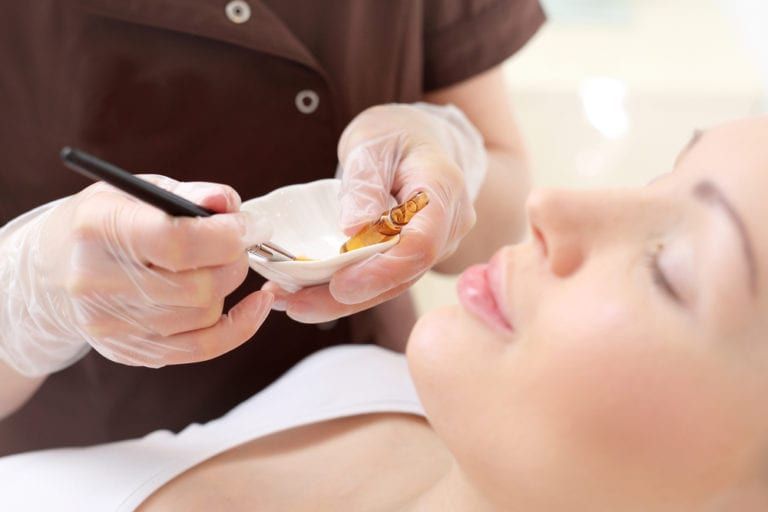What can a chemical peel do for my skin?
Chemical peels can make a dramatic difference in the surface of your skin. They can smooth texture, improve fine lines, lighten pigment such as melasma, fade sun spots, and treat acne.
What type of chemical peel is right for me?
Chemical peels are categorized by how deeply they penetrate the skin: superficial, medium or deep. Superficial peels penetrate the superficial epidermal layer of the skin. They are usually performed in a series of 2-3 to treat fine lines, acne, pore size, and hyperpigmentation. A medium depth peel is for patients with moderate sun damage, whereby, the age spots and wrinkles are more significant. Deep chemical peels were traditionally performed with phenol, but this is not done any longer as laser resurfacing became popular.
The main chemicals used for peels fall into two categories: water soluble such as AHAs and TCA and oil soluble such as BHA. The addition of other acids such as lactic acid, mandelic acid, resorcinol and salicylic enhance results.
The type and depth of chemical peel administered depends on what you are trying to treat, how much downtime you want, your Fitzpatrick skin type and the degree of sun damage. It is very important to be properly evaluated so that the peel can be customized for you and your problems can be diagnosed.
Hyperpigmentation is actually a rather complex problem which should not be casually dismissed. Does the pigment represent sun freckles, age spots, post inflammatory hyperpigmentation, or melasma. There is even a type of melanoma called Lentigo Maligna Melanoma that appears as a freckle. I have had several patients be diagnosed with this type of melanoma when they wanted a peel for “pigmented freckles.” This information is not meant to frighten but inform. Make sure you see a Board Certified Dermatologist, prior to bleaching creams or chemical peels, when there is any question about pigment on the skin.
What will I experience during a chemical peel?
A superficial chemical peel will produce a slight burning, tingling sensation on the skin for 3-5 minutes. The mild discomfort subsides once the peel is neutralized. We provide a fan that patients can hold close to their face during the peel which helps reduce any discomfort.
A medium depth peel has a more intense stinging feeling on the skin when it is applied. These symptoms are felt longer approximately 15-20 minutes. For some patients, a numbing cream can be applied at the office prior to the peel. Again, a fan held close to the face really helps. At the end of the peel, we also use icy cold clothes to reduce the heat.
What happens after the peel?
A superficial peel can produce some redness but it usually lasts less than 12 hours. Some superficial peels in patients with sensitive skin can produce mild redness for 3-4 days. After the redness, the skin may flake and exfoliate more than usual. Some superficial peels used for acne don’t exfoliate much at all, but rather leave the skin feeling tight for several days while oil glands and pores are shrinking.
A medium depth chemical peel requires downtime. The skin is very red like a sunburn and sensitive for 2-4 days. After the redness fades, the skin turns darker tan color and crusts. The peeling is similar to after a sunburn, but heavier. These type of peels require special lots of special moisturizer applied multiple times a day for 1-10 days. No makeup is recommended for a week. For the best results, a week of downtime should be expected.
What are the possible side effects and complications of peels?
Pain, redness, wound healing concerns, pigment changes, swelling, scarring, infection, harmful eye exposure, sun sensitivity, and cold sores.
It is essential that a patient is evaluated prior to the peel and the correct type of peel is chosen for the skin problem. The peel needs to be performed in the proper manner and knowledge of chemicals and neutralizers mastered.
All the side effects can be avoided or managed without complications. Peels are very popular in my practice for that reason. Chemical peels give terrific results even though they may sound scary to patients who have not tried them.
What can patients do to improve their results with chemical peels?
Peel prep is the key. The results that you achieve with your peel is affected by the products you use at home in the weeks leading up to your treatment.
Here are some tips that may surprise you.
Skip your workout the morning before your peel. Working out dramatically increases the circulation within the skin, leaving it over stimulated before a peel. This could make the skin become irritated by the chemicals in the peel. Sweat and dehydration of the skin also makes the skin cells not optimal to respond to the chemical.
Stay hydrated. Drink plenty of water in the days leading up to your treatment. Dehydration can sensitize the skin making it more prone to a negative result.
Exfoliate. Using products that exfoliate the skin a few weeks before your peel helps to give a stronger result from the chemical peel. Such products can be retinol, retin A, beaded cleansers, glycolic lotions and cleansers. However, it is important to stop exfoliation products two days before your chemical peel so that the skin is not to sensitive.






